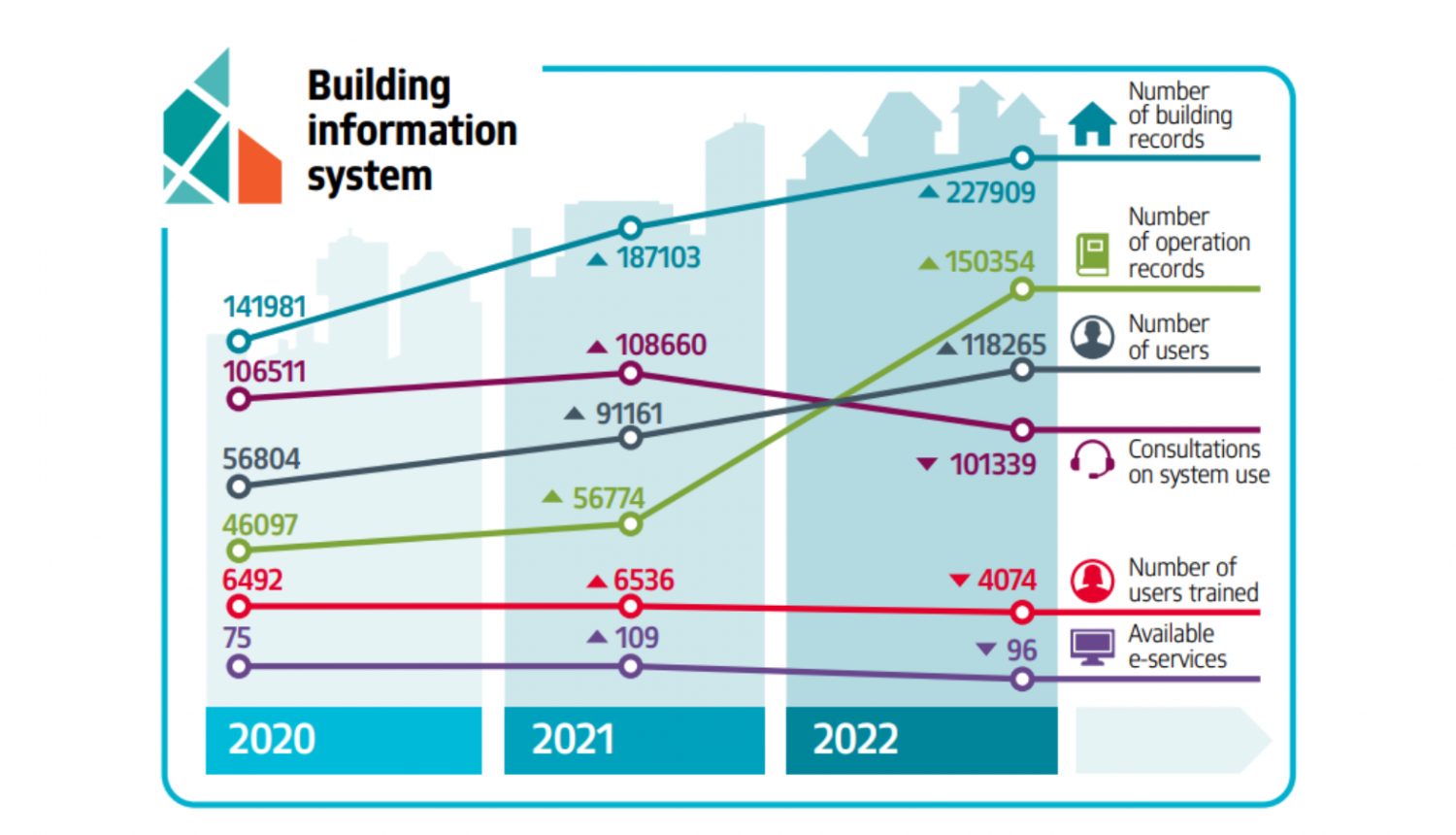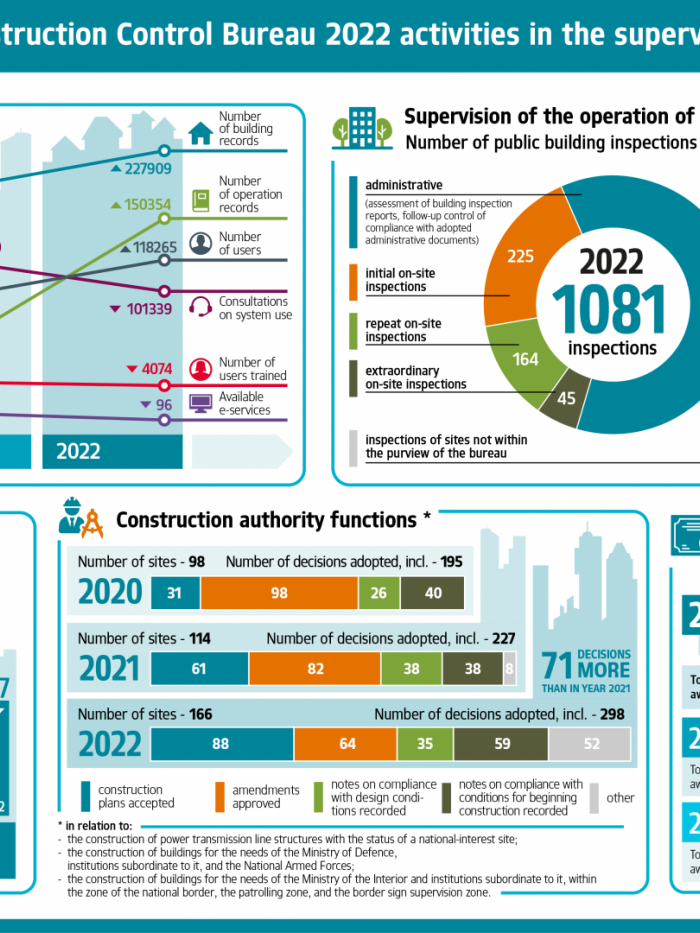The number of operation records created in the Building Information System (BIS) almost tripled last year, as compared to 2021. The reason is that starting in March this year, house managers must create an electronic house record, and some began doing it early.
Data about the BIS online services also confirm that house managers have been getting more active with their new duties: the number of applications for updating information in the register of residential building managers increased from 6 to 153 during the year, and the number of applications for registration, from 11 to 79.
Other BIS indicators have also grown significantly, including the number of system users and the number of building records available in the system. The number of e-services available decreased slightly due to the streamlining of processes. System user training had been taking place regularly over the previous few years, and the number of users that underwent the training decreased in 2022, and fewer consultations on the use of the system were provided.
While Round II of the BIS development project, which took three years and support of the European Regional Development Fund (ERDF), ended in December 2022, the development of the system did not stop there, and additional measures will be implemented as part of an extension of the project, by December this year.
Amendments to the special construction regulations took effect in late 2021 and early 2022, removing or combining a few construction plan types (certification cards for buildings and engineering structures were eliminated, and several types of explanatory documents were combined). As a result, certain online construction services (such as the construction notice) were registered significantly more often.
In 2022, SCCB conducted construction control at 317 sites. There is a decrease compared to previous years, one of the explanations for this being changes in the selection criteria for the sites that are subject to SCCB construction control set in the Construction Law. During the year, SCCB started the supervision of construction at 259 new sites. 196 sites were commissioned. As part of the ‘Consult first’ meetings, recommendations were issued to 745 construction participants, and 738 reports on the inspection of structures were prepared during construction control activities. Breaches were found in 199 or 30% of the cases, mainly due to the construction work not complying with the construction design or due to construction products that do not have documentation certifying compliance. At 49 sites, the construction contractor quality control system (QCS) was assessed according to the criteria set by SCCB, and found to have been developed in accordance with the special construction regulations. Furthermore, a large part of the construction contractors used the guidelines issued by SCCB in setting up the system. In the cases where construction participants had implemented a QCS, the number of deficiencies found during inspections was lower.
In 2022, 434 physical inspections took place as part of supervising the operation of public buildings. The number of physical inspections carried out by SCCB increased, because Riga municipal government requested the Bureau to conduct more intensive inspections of gambling venues in the capital. In 209 cases, follow-up inspections were carried out to ensure compliance with SCCB instructions or administrative orders issued. 8% of the buildings were found to be in emergency or pre-emergency state. A year earlier, this indicator was twice as high, at 17%, due to the fact that in 2021, the Bureau conducted follow-up inspections of buildings in emergency or pre-emergency state to confirm that there had been changes in their technical condition. In 2022, 55% of the buildings surveyed were in excellent or good condition (compared to 18% in 2021), while the safety of 35% of buildings needed to be improved (66% in 2021). In 32% of the cases, the building owners had still not performed regular technical inspections of their buildings, a better result than in 2021, when the inspections were only carried out by 19% of the owners. Group two and three public buildings commissioned before 1 October 2014 that have not undergone a technical inspection within the last 10 years, must be inspected by 31 October 2024.
‘Public safety is in the hands of building owners. However, the understanding that every building owner has an obligation to make sure that the building meets basic requirements, such as mechanical strength and stability, fire safety, operating safety, develops very slowly. This is confirmed by the data available to our institution. Though there is still time to meet the obligations set in the regulations, I urge building owners not to postpone the regular technical inspections of their buildings. These inspections make it possible to assess the technical condition of the building and identify possible risks,’ head of SCCB Svetlana Mjakuškina said.
Last year, in order to work towards a uniform approach to technical inspections, SCCB specialists joined a working group organised by the Ministry of Economics to develop guidelines for technical inspections. The work on developing an algorithm for determining the risk level in building operation records was completed, as a result of which SCCB is starting a systematic review of public buildings based on risk analysis.
As part of its function as a construction authority, the SCCB construction authority commission worked on 150 construction records related to the construction of military facilities, 14 construction records related to the construction of national border infrastructure, and 2 construction records related to the construction of power transmission lines with the status of a national interest site. 298 decisions were adopted, of which 259 decisions pertained to the construction of buildings for the needs of the Ministry of Defence, institutions subordinate to it, and the National Armed Forces.
SCCB certified 194 construction experts by the end of 2022. The number of certificates issued is greater than the number of specialists certified, as some specialists received multiple certificates in different fields. In 2022, SCCB examined complaints about alleged professional violations by 9 construction specialists, and in one of these cases, a decision was made to issue a warning in the field of expert review of architectural solutions in construction designs. In addition, 7 complaints were received concerning alleged professional violations by construction specialists and forwarded to other certification bodies based on their competence. A survey of 52 certified construction experts was conducted to assess the quality of the services provided. Its results show that since 2021, there has been a tendency to better satisfy the wishes of clients and better meet the requirements for the public availability of the necessary information.
During 2022, information about 214 main construction contractors, 1384 subcontractor contracts, 488 construction sites, and 96,234 workers construction sites was registered in the single electronic working time database (VEDLUDB) maintained by SCCB. While the number of main construction contractors and construction sites did not change significantly, the number of registered construction site workers doubled in 2022: a year earlier, it was 43,169. This points to the positive role of VEDLUDB in combatting illegal employment and informal economy.




